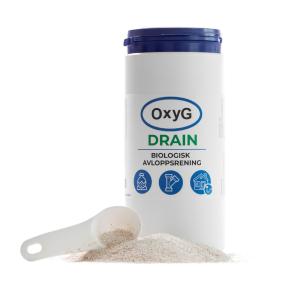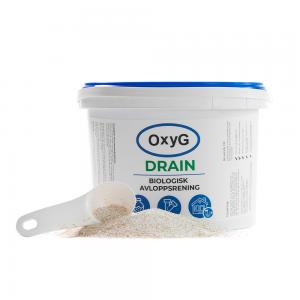- Totalt 0 kr
Drain
Common problems that OxyG Drain can solve:
- Odor problems
- sludge
- Grease/ fat
- sludge and fat escape
In case of sludge or grease escape from the septic tank, this means that the size of the sludge separator/ septic tank is usually too small, even if the size of the sludge separator follows the recommendations. The wastewater you produce needs more time to separate sludge and grease in the sludge separator.
There are really only two ways to solve the problem.
- Install a larger sludge separator/ septic tank (especially relevant when a new sludge separator is built/ install
- Increase the rate of decomposition in the sludge separator of the organic material with the help of bacteria, which will provide a cleaner wastewater out of the sludge separator to treatments plant or leach field, infiltration
OxyG Drain is a product intended to be added to sewage systems with the intention of increasing the decomposition rate of the sewage's organic material and in the decomposition process removing bad odors.
The purpose of OxyG Drain is to add selected bacteria from nature to improve the biological water purification process so that the process becomes more efficient and faster. OxyG uses bacillus bacteria that are scientifically known to be a good decomposer of organic carbon chains, which bacillus does in nature. The bacteria are from a non-pathogenic hazardous bacterial cultures.
Dosage: 4 cups / adult / month takes place via the toilet and after dosing flush as usual. It is also possible to dose the monthly dose via a sink, sink or in a floor drain shower if you have problems with grease clogging the pipes. It is important to keep in mind that when dosing in a water trap, you do it in the evening so that the bacteria can grow overnight in the water trap and then flush as usual the next day. Then the bacteria are flushed down and form a biofilm in the pipes that break down grease and deposits. If the drain pipes run as they should, then just dose in the toilet and flush.
Bioremediation in septic tank systems can offer several benefits by harnessing natural microbial processes to break down and treat sewage. Here are some reasons to consider using bioremediation in septic tank systems:
- Efficient Waste Breakdown:
- Bioremediation relies on microorganisms to break down organic matter in sewage efficiently. This natural process helps reduce the volume of solids in the septic tank, preventing premature filling and the need for frequent pumping.
- Reduced Odor and Gas Emissions:
- The microbial activity involved in bioremediation can contribute to the decomposition of organic materials, helping to minimize unpleasant odors associated with septic tank systems. Additionally, the process can assist in reducing the emission of gases that might be produced in anaerobic conditions.
- Improved Treatment of Wastewater:
- Bioremediation aids in the transformation of complex organic compounds into simpler, less harmful forms. This process contributes to the treatment of wastewater, making it less environmentally impactful when released into the drain field or leach field.
- Enhanced Nutrient Removal:
- Certain microbial activities in bioremediation processes can promote the conversion of nutrients, such as nitrogen and phosphorus, into forms that are less likely to cause environmental harm. This helps in preventing nutrient leaching into groundwater and potential contamination of nearby water bodies.
- Extended System Lifespan:
- By promoting the natural breakdown of organic matter and preventing the accumulation of solids, bioremediation can contribute to the longevity and efficiency of septic tank systems. This can reduce the frequency of necessary maintenance and extend the overall lifespan of the system.
- Adaptability to Varying Conditions:
- Bioremediation is often more adaptable to changes in environmental conditions compared to some chemical treatments. The diverse microbial communities involved can adjust to fluctuations in temperature, pH, and other factors, maintaining a more stable treatment process.
- Cost-Effective and Sustainable:
- Bioremediation is generally a cost-effective and sustainable approach to septic tank management. It relies on natural processes, reducing the need for chemical additives and potentially lowering overall operational costs.
- Minimization of Groundwater Contamination:
- Effective bioremediation can contribute to the reduction of contaminants reaching the groundwater, safeguarding the quality of local water resources and minimizing the environmental impact of septic tank systems.
It's essential to note that the success of bioremediation in septic tank systems depends on various factors, including the design of the system, microbial populations, and maintenance practices. Regular inspection, appropriate microbial supplements, and adherence to recommended guidelines can optimize the effectiveness of bioremediation in septic tank systems.
Mikael Pell, Professor of Environmental Microbiology at the Swedish University of Agricultural Sciences (SLU) reviews the basics of microbiology in soil-based sewage systems. A guide to the life and living of microbes in the different parts of the plant. (in Swedish)



